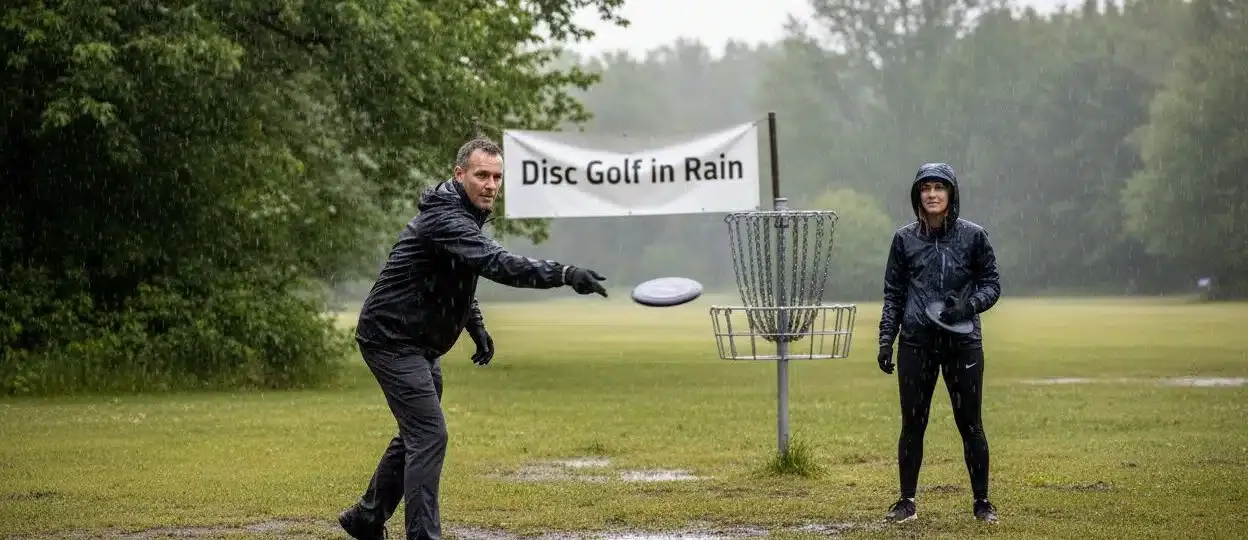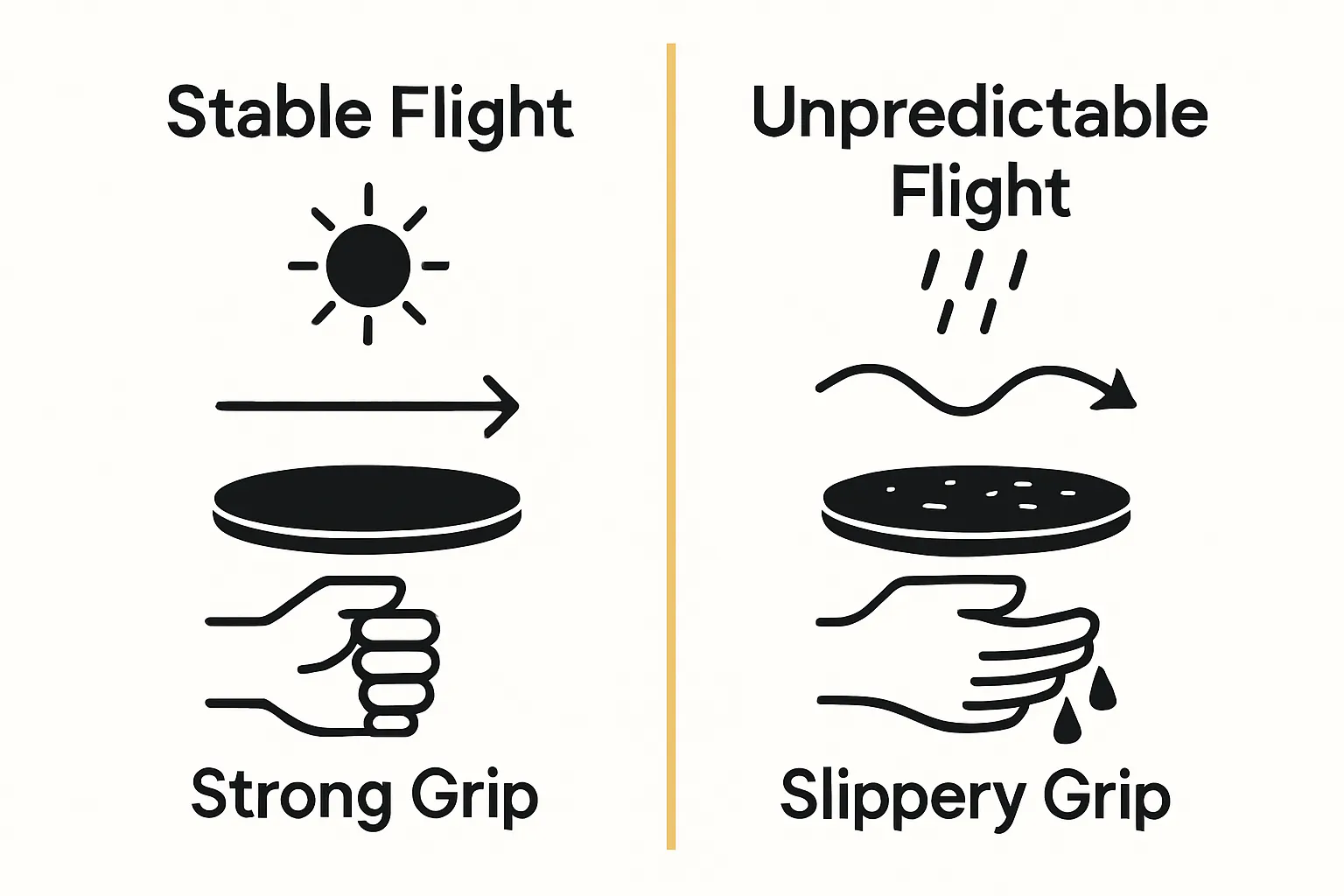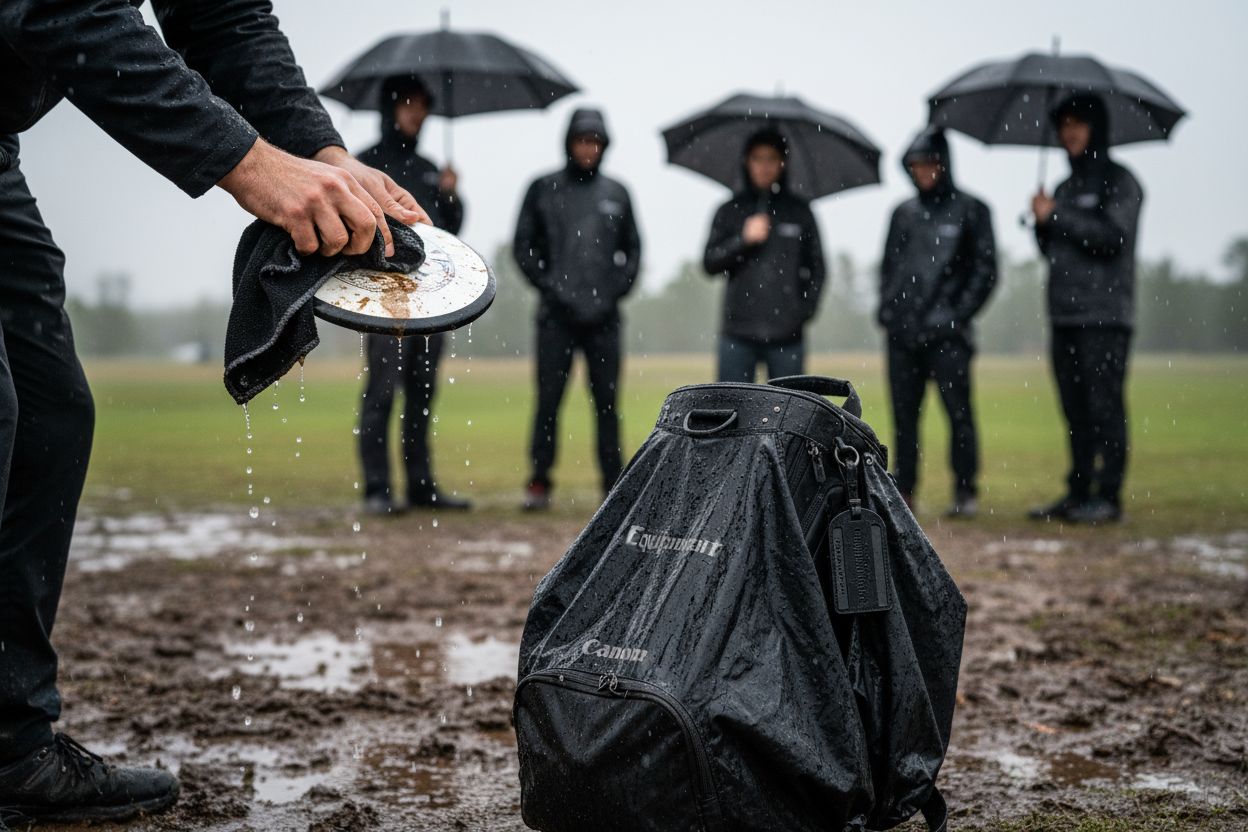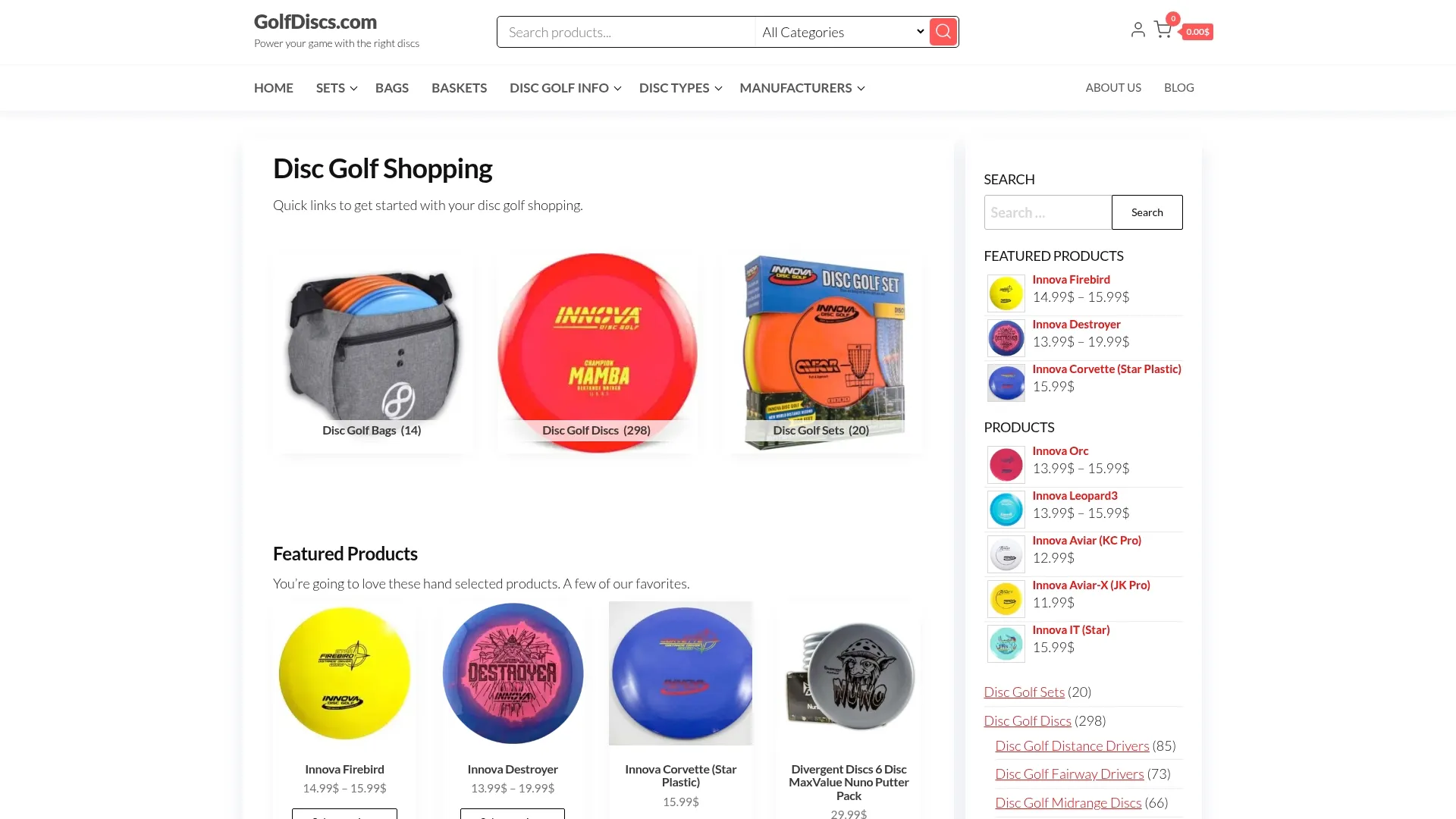
Understanding Disc Golf in Rain: What You Need to Know
Disc golf might look simple at first glance, tossing discs toward a chain basket on a sunny afternoon. But consider this. Moisture can reduce your grip and send your best throw wildly off course just because of a light drizzle. The real surprise is that rainy conditions do not just make the sport harder. They actually push players to develop sharper skills and even turn a drenched fairway into a true test of mental grit and adaptability.
Table of Contents
- What Is Disc Golf And How Rain Affects It?
- The Importance Of Weather Conditions In Disc Golf
- How Rain Impacts Disc Selection And Game Strategy
- Maintaining Equipment And Safety In Rainy Conditions
- Real-World Experiences Of Disc Golf In Rain
Quick Summary
| Takeaway | Explanation |
|---|---|
| Adjust throwing techniques in the rain. | Modify grip strength and release angles to maintain control when discs are slippery. |
| Choose stable discs for wet conditions. | Use overstable and heavier discs to ensure predictable flight paths despite moisture affecting aerodynamics. |
| Maintain equipment regularly after rain. | Clean and dry discs and bags promptly to prevent damage from prolonged moisture exposure. |
| Use waterproof gear for personal safety. | Wear waterproof footwear and clothing to reduce slip risks and ensure comfort during play. |
| View rain as a training opportunity. | Embrace challenging weather for skill development, enhancing adaptability and resilience in gameplay. |
What is Disc Golf and How Rain Affects It?
Disc golf is a dynamic outdoor sport that combines elements of traditional golf with frisbee throwing. Learn more about the fundamental principles of disc golf and understand how environmental conditions like rain can dramatically impact gameplay.
The Basics of Disc Golf
Unlike traditional golf, disc golf is played using specialized flying discs instead of golf balls and clubs. Players aim to complete a course with the fewest number of throws, targeting metal basket targets positioned across varied terrains. Each course typically features 9 to 18 holes, with players navigating through woods, open fields, and challenging landscapes.
The sport requires precision, strategy, and an understanding of disc aerodynamics. Players use different types of discs – drivers for long distances, midrange discs for moderate throws, and putters for short, accurate shots near the target basket.
Rain’s Impact on Disc Golf Performance
Rain introduces significant challenges to disc golf gameplay. Wet conditions fundamentally alter disc flight characteristics and player performance. Moisture reduces disc grip, making throws less predictable and increasing the likelihood of errant shots.
 Discs become slippery, which can cause unintended release angles and reduced control.
Discs become slippery, which can cause unintended release angles and reduced control.
Key rain-related challenges include:
- Reduced disc stability and predictable flight paths
- Increased risk of disc slipping during release
- Muddy terrain affecting player footing and throwing mechanics
- Potential damage to specialized disc golf equipment
Adapting to Wet Weather Conditions
Successful disc golfers learn to adjust their techniques during rainy conditions. This involves using specialized rain gear, selecting more stable disc types, and modifying throwing techniques to compensate for reduced grip and altered aerodynamics. Understanding how moisture impacts disc performance becomes crucial for maintaining competitive play.
By recognizing rain’s effects and preparing accordingly, players can transform challenging weather into an opportunity for skill development and resilience.
The Importance of Weather Conditions in Disc Golf
Weather plays a critical role in disc golf performance, transforming the game from a simple recreational activity into a nuanced test of skill and adaptability. Learn more about seasonal disc golf challenges and how environmental factors can dramatically impact player strategies.
Understanding Weather’s Impact on Disc Flight
Disc golf is uniquely sensitive to atmospheric conditions. Wind, temperature, humidity, and precipitation directly influence disc aerodynamics and player performance. Air density and wind speed are particularly crucial factors that modify disc trajectory, requiring players to constantly adjust their throwing techniques.
When air is denser, such as during cooler temperatures or higher humidity, discs experience more resistance. This resistance can cause discs to behave differently than expected, creating additional complexity for players attempting precise throws.
Temperature and Disc Performance
Temperature significantly affects disc behavior. In cold conditions, disc plastic becomes stiffer and less flexible, which can reduce its ability to generate spin and maintain stable flight paths. Conversely, extremely hot temperatures can make disc plastic more pliable, potentially altering its fundamental aerodynamic properties.
Key temperature-related disc performance factors include:
- Reduced disc flexibility in cold weather
- Changes in disc material elasticity
- Altered grip characteristics across temperature ranges
- Potential warping or deformation in extreme temperatures
Strategic Weather Adaptation
Successful disc golfers develop a deep understanding of how different weather conditions impact their game. This involves selecting appropriate discs, modifying throwing techniques, and maintaining mental flexibility. Professional players often carry multiple disc types to accommodate varying weather scenarios, ensuring they can perform effectively under diverse environmental challenges.
By recognizing and respecting weather’s complex influence, disc golfers transform potential obstacles into opportunities for skill development and strategic gameplay.
The table below compares how common weather conditions impact disc golf disc performance and player strategy. This helps readers quickly understand the different adaptations needed for rain versus other challenging weather.
| Weather Condition | Impact on Disc Performance | Effect on Player Technique | Equipment/Strategy Adaptation |
|---|---|---|---|
| Rain | Reduced grip; unpredictable flight path | Adjust grip and release angles | Use overstable/heavier discs; waterproof gear |
| Cold Temperatures | Stiffer, less flexible discs | May reduce throwing power, need for more spin | Use softer/plastic discs; extra hand warmers |
| Hot Temperatures | Discs become more pliable; possible warping | Requires grip adjustments | Keep discs shaded; rotate discs to avoid heat |
| Wind | Disc flight path less predictable | Modify throwing angle and power | Choose more stable discs; lower power throws |
| Humidity | Air denser; increased resistance | Subtle grip and throw adjustments | Monitor disc selection for added resistance |
How Rain Impacts Disc Selection and Game Strategy
Rain dramatically transforms disc golf dynamics, requiring players to make sophisticated equipment and strategic adjustments. Explore advanced rain protection gear for disc golf to understand how professional players prepare for challenging weather conditions.
Disc Stability and Moisture Interaction
Rain fundamentally alters disc aerodynamics by changing surface friction and weight distribution. Moisture creates a slick disc surface, which reduces grip and predictability during throws. Players must select discs with higher stability ratings to compensate for decreased control, focusing on discs that maintain consistent flight paths even in wet conditions.
Stable, overstable discs become crucial during rainy gameplay. These discs resist turning and provide more predictable trajectories when standard throwing mechanics are compromised by wet conditions. Heavier discs also offer more consistent performance, as they are less susceptible to wind and moisture variations.
Strategic Disc Selection Considerations
Choosing the right disc during rainy conditions involves understanding complex interactions between disc design and environmental factors. Players prioritize discs with the following characteristics:
- Higher stability ratings
- Overstable flight characteristics
- Heavier weight classes
- Textured plastic materials
- Minimal surface friction
Adapting Throwing Techniques
Successful rain disc golf requires more than equipment selection. Players must modify their throwing techniques to maintain accuracy and control. This involves adjusting grip strength, release angles, and follow-through mechanics to compensate for reduced friction and unpredictable disc behavior.
Advanced players develop nuanced techniques like reducing throwing power, using more wrist snap for spin, and selecting shorter, more controlled throwing arcs.
By understanding how rain impacts disc performance, players transform potential limitations into strategic advantages.
Maintaining Equipment and Safety in Rainy Conditions
Rain presents unique challenges for disc golf equipment maintenance and player safety. Explore comprehensive disc golf gear protection strategies to ensure optimal performance and personal well-being during wet conditions.
Equipment Protection Techniques
Protecting disc golf equipment from moisture requires proactive and strategic approaches. Wet conditions can cause rapid degradation of discs, bags, and accessories if proper care is not taken. Players must focus on preventing water damage, maintaining disc integrity, and preserving equipment functionality.
Professional disc golfers utilize specialized waterproof gear and techniques to shield their equipment. This includes using water-resistant disc bags, applying protective sprays, and implementing quick-dry storage methods that prevent long-term moisture absorption and potential material breakdown.
Personal Safety and Gear Considerations
Players must prioritize personal safety and comfort when navigating rainy disc golf environments. Wet terrain increases slip risks, reduces visibility, and creates potentially hazardous playing conditions. Essential safety considerations include:
- Wearing waterproof, non-slip footwear
- Using moisture-wicking clothing layers
- Carrying quick-dry towels for equipment maintenance
- Utilizing waterproof bag covers
- Implementing grip-enhancement techniques
Post-Rain Equipment Maintenance
Proper equipment care after playing in rainy conditions is crucial for preserving disc performance and longevity. Immediate post-game maintenance prevents potential long-term damage caused by prolonged moisture exposure. Players should develop systematic cleaning and drying protocols that include thorough disc inspection, removing mud and debris, and ensuring complete equipment dry-out.

By implementing comprehensive equipment protection and maintenance strategies, disc golfers can confidently play in diverse weather conditions while preserving their valuable gear and ensuring personal safety.
This table summarizes the primary equipment protection and personal safety techniques highlighted in the article to help readers choose the best methods for playing disc golf safely and effectively in rainy conditions.
| Protection/Safety Technique | Purpose | Example Application |
|---|---|---|
| Waterproof bags/covers | Keep discs and gear dry | Water-resistant disc golf backpacks |
| Quick-dry towels | Remove moisture from discs/equipment | Towel off discs after each throw |
| Moisture-wicking clothing | Improve comfort and reduce chafing | Wear technical sportswear, base layers |
| Non-slip/waterproof footwear | Prevent slipping and falls | Use trail running shoes or hiking boots |
| Protective sprays | Reduce water absorption on discs | Apply disc-specific waterproof sprays |
| Post-play cleaning/drying | Prevent long-term gear damage | Dry bags and discs thoroughly at home |
Real-World Experiences of Disc Golf in Rain
Discover the unexpected rewards of playing disc golf outdoors, where challenging weather conditions test a player’s true skill and resilience. Rain transforms disc golf from a casual recreational activity into a complex mental and physical challenge that separates casual players from dedicated enthusiasts.
Psychological Challenges of Rainy Gameplay
Wet conditions dramatically alter player mentality, requiring exceptional focus and emotional control. Professional disc golfers understand that rain is not a deterrent but an opportunity to demonstrate adaptability. The psychological aspect of playing in rain involves maintaining composure when traditional throwing techniques become unreliable.
Players must quickly transition from frustration to strategic problem-solving. Each unexpected disc deviation becomes a moment of learning, where mental flexibility determines performance more than physical skill. The ability to remain calm and adjust throwing techniques in real-time separates experienced players from novices.
Performance Variability in Wet Conditions
Rain introduces unpredictable variables that challenge even the most experienced disc golfers. Disc flight paths become less consistent, requiring instantaneous recalibration of throwing techniques. Players report significant performance variations, including:
- Increased throw inaccuracy
- Reduced disc control
- Higher likelihood of unexpected disc movements
- Greater physical and mental fatigue
- Increased risk of equipment damage
Learning and Growth Through Challenging Weather
Experienced disc golfers view rainy conditions as a unique training ground for skill development. Adverse weather becomes a masterclass in adaptability, pushing players beyond their comfort zones. Tournament-level players often intentionally practice in challenging conditions to build comprehensive skill sets that transcend ideal weather scenarios.
By embracing rain as a teacher rather than an obstacle, disc golfers develop a more nuanced understanding of their sport. The lessons learned during wet gameplay extend far beyond disc golf, teaching resilience, strategic thinking, and mental toughness that apply to numerous life challenges.
Ready to Play Your Best Disc Golf Game Even in the Rain?
Has wet weather ever made you question your grip or left your discs slipping through your fingers? You are not alone. Many disc golfers face frustration when moisture changes equipment performance and strategy. This article explained just how much rain can impact your throws and how the right preparation is key to transforming challenges into moments of growth. The right discs and gear make all the difference in holding your advantage when the skies open up. If you have ever wished for more stability or control on a rainy day, better solutions are already within your reach.

Now is the perfect time to upgrade your equipment for any weather. Explore our full range of rain-ready discs, waterproof bags, and essential accessories at golfdiscs.com. Choose gear built for all conditions so you can focus on the game, not the weather. Start shopping now to play your best round—rain or shine—by visiting golfdiscs.com and equip yourself for your next challenge.
Frequently Asked Questions
What is disc golf, and how is it played in the rain?
Disc golf is an outdoor sport that combines frisbee throwing with traditional golf elements. In the rain, players must adapt their techniques due to wet conditions that affect disc grip and aerodynamics, making throws less predictable.
How does rain affect disc flight and throwing techniques?
Rain creates a slick disc surface that reduces grip, leading to unstable throws. Players may need to adjust their grip strength, release angles, and throwing arcs to maintain accuracy and control in wet conditions.
What types of discs are best for rainy weather?
When playing in the rain, it’s advisable to choose more stable, overstable discs with higher stability ratings. Heavier discs also tend to perform better since they are less affected by moisture and wind.
How can I protect my disc golf equipment in rainy conditions?
To protect your equipment from moisture, consider using waterproof bags, applying protective sprays, and having quick-dry towels on hand for maintenance. Also, ensure to clean and dry your discs thoroughly after playing in the rain to prevent long-term damage.
